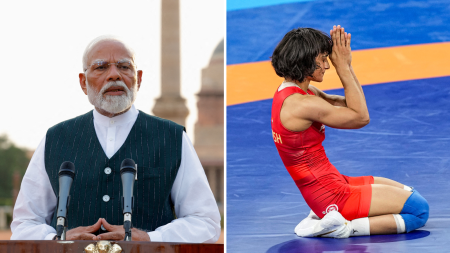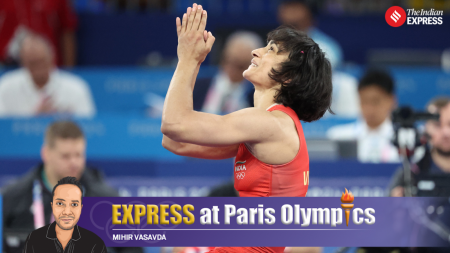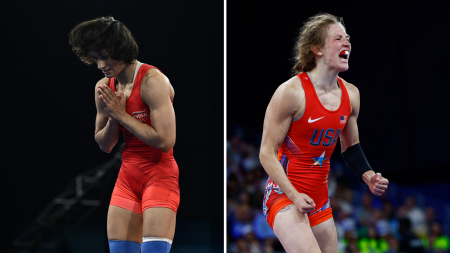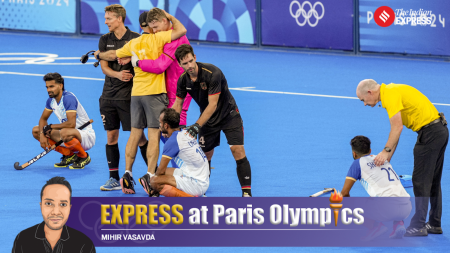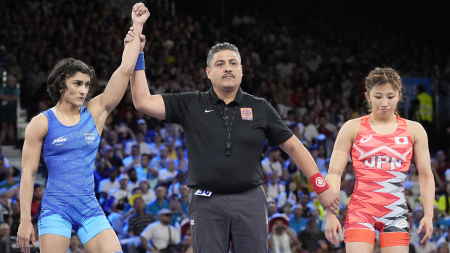Explained: Why Vinesh Phogat failed weigh-in at Paris Olympics; why and how wrestlers cut weight
Vinesh Phogat will not medal at the Paris Olympics. The Indian 50 kg wrestler failed to make a crucial second weight cut on Wednesday morning, to be able to take part in the gold medal bout.
What is a weight cut?
Wrestlers, boxers and combat sport athletes have weight categories in which they participate. These categories have rules in place that don’t allow athletes above that weight to participate in that competition. Essentially, sport does not want a bigger athlete to compete against a smaller athlete. But sometimes bigger athletes choose to cut weight, that is rapidly losing a set number of kilos before competition. It’s quite a common practice in combat sports.

When do wrestlers weigh in?
According to United World Wrestling’s (UWW) Olympics weigh- in rules, wrestlers have to weigh in on the morning of their competition. But before the weigh-in on Day 1, a wrestler is supposed to appear at a medical examination with their licence and accreditation, while wearing their singlet. The weigh-in period is 30 minutes on Day 1 and a wrestler can try weighing themselves multiple times. On Day 2, if applicable, a wrestler has 15 minutes to make the weight and this too is done on the morning of the competition.
Why was it tough for Vinesh Phogat to cut weight?
Vinesh has always struggled to cut weight for the 50kg category. She had been participating in the 53 kg category until recently before she made the switch to 50 kg. The switch was made at the trials in NIS, Patiala. Phogat’s usual weight is around 55-56 kg, which she has to cut to 50 kg on the days of competition. Keeping her body weight below 55-56 kg has proved to be quite tough as there isn’t much more weight to cut and cutting water weight by sweating out has proven to be extremely challenging for the Indian wrestler.
Vinesh Phogat disqualification live updates
Why was she disqualified despite making the weight on the first day?
UWW rules state that an athlete needs to make the weight on all competition days. Since the Olympic wrestling competition in a weight category is held over two days, Vinesh needed to weigh 50kg or under on both days. And since she was not able to do so on Day 2, she was disqualified.
According to UWW, “If an athlete does not attend or fails the weigh-in (the 1st or the 2nd weigh-in), he will be eliminated from the competition and ranked last, without rank. If an athlete is injured during the first day, he doesn’t have to attend the second weigh-in and will keep his results.”
Could Vinesh have salvaged a medal if she was injured?
According to UWW, if an athlete is injured during the first day, he/she doesn’t have to attend the second weigh-in and will keep his results. In Vinesh’s case, she would have got the silver medal.
But if an athlete is injured after Day 1 of the competition, they have to attend the second weigh-in, according to the UWW.
“For all the other types of injuries or diseases that happen after the first day of competition and out of competition, the concerned athlete will have to attend the second weigh-in, otherwise he will be eliminated from the competition and ranked last, without rank.”
Why do Olympic wrestlers have to weigh in on two days?
At the Olympics, starting rounds to semi-finals take place on the first day, and the gold medal and repechage rounds on the next day. If an Olympic wrestler has matches on the second day, they are bound to weigh in again on the second day, since they will be competing on that day as well.
Was a two-day weigh-in always the rule?
No. In 2017, the UWW changed the format of Olympic wrestling. So instead of the competition in a weight category being conducted all in a day, they moved to a two-day system. This was done so that athletes wouldn’t lose a huge amount of weight on one day and compete.
How can a wrestler weigh two kilos higher on Day 2, after weighing 50 kg on Day 1?
Most wrestlers rely on extreme weight cutting measures in the last few days before a competition. This involves not loading any carbohydrates, not drinking water, and intense exercising. The main way a body loses weight quickly is through losing water. Many combat athletes often try to use saunas and cover themselves up and exercise in order to make the body produce more sweat.
In the case of two-day Olympic wrestling, Phogat weighed 50 kg on the first day and was able to compete. But through the day, the last couple of kgs that she had lost came back. She then spent the entire time after competition on Day 1 to Day 2’s morning weigh-in trying to get her body to cooperate but missed out by a few grams.
Disclaimer: The copyright of this article belongs to the original author. Reposting this article is solely for the purpose of information dissemination and does not constitute any investment advice. If there is any infringement, please contact us immediately. We will make corrections or deletions as necessary. Thank you.
